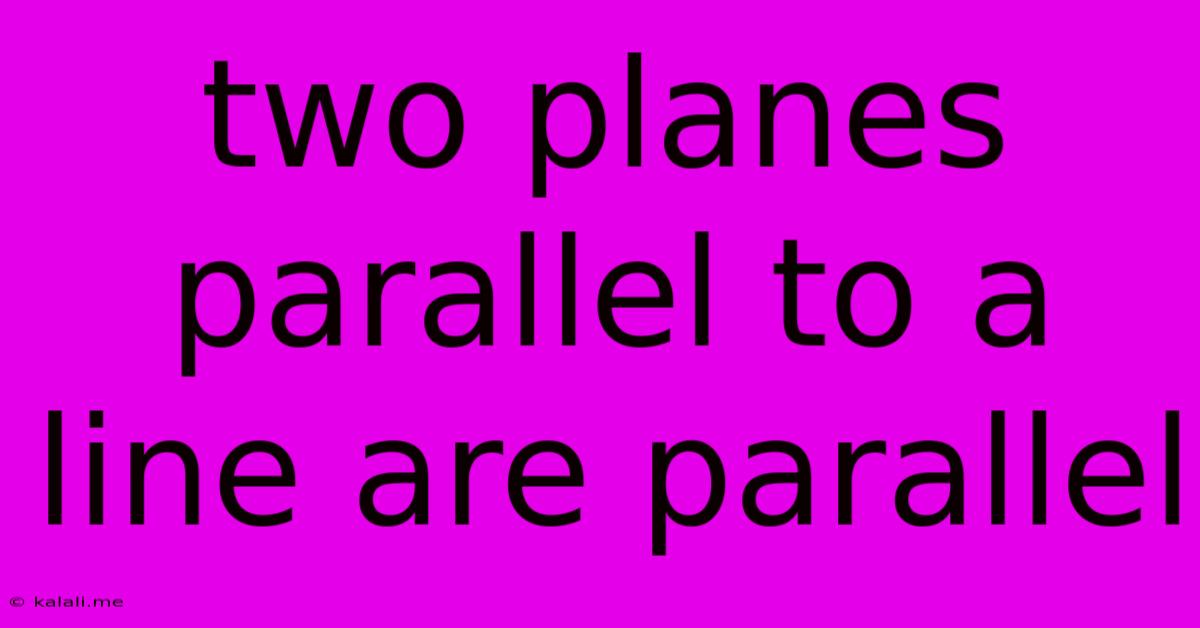Two Planes Parallel To A Line Are Parallel
Kalali
Jun 02, 2025 · 3 min read

Table of Contents
Two Planes Parallel to a Line are Parallel: A Geometric Proof
This article will provide a comprehensive explanation and proof of the geometric theorem: if two planes are both parallel to the same line, then the two planes are parallel to each other. Understanding this theorem is crucial for grasping spatial relationships in three-dimensional geometry and is frequently encountered in advanced mathematics and engineering. We will explore this concept using both intuitive reasoning and a formal geometric proof.
Understanding Parallelism in Three Dimensions
Before diving into the proof, let's establish a firm understanding of parallelism in three dimensions. A line and a plane are parallel if they do not intersect. Two planes are parallel if they do not intersect; if they were to intersect, they would do so along a common line. Visualizing these relationships can be challenging, so it's helpful to use physical models or interactive 3D geometry software to build intuition.
The Proof: Demonstrating Parallel Planes
We will utilize a proof by contradiction. This method assumes the opposite of what we want to prove and demonstrates that this assumption leads to a contradiction, thereby validating our original statement.
1. The Assumption:
Let's assume we have two planes, Plane A and Plane B, both parallel to a line, Line L. We will assume that Plane A and Plane B are not parallel to each other.
2. The Contradiction:
If Plane A and Plane B are not parallel, they must intersect. This intersection would form a line, let's call it Line M.
3. The Problem:
Now, consider the relationship between Line L and Line M. Since Line M lies within both Plane A and Plane B, and both planes are parallel to Line L, Line M must also be parallel to Line L (this is a consequence of the properties of parallel planes and lines).
However, this creates a contradiction. If Line M and Line L are parallel and both lie within the same plane (either Plane A or Plane B), they cannot intersect. Yet if we extend Line M, it must eventually intersect Line L (unless they coincide, which isn't the case here). This is a fundamental contradiction in Euclidean geometry.
4. The Conclusion:
The contradiction arises from our initial assumption that Plane A and Plane B are not parallel. Therefore, our assumption must be false. This proves that if two planes are both parallel to the same line, the two planes must be parallel to each other.
Applications and Extensions
This seemingly simple theorem has broad applications in various fields:
- Computer Graphics: Understanding parallel planes is crucial for rendering 3D scenes and performing transformations accurately.
- Engineering and Architecture: This principle is vital for constructing stable and accurate structures. Parallel planes are used to ensure that components of a building or machine align correctly.
- Linear Algebra: The concept is fundamental to understanding vector spaces and linear transformations in higher dimensions.
This geometric proof highlights the power of deductive reasoning in mathematics. By starting with basic axioms and definitions, we can rigorously derive complex relationships between geometric objects, enabling us to understand and solve problems across diverse fields. Remember, understanding the underlying principles is key to mastering more advanced concepts in geometry and related areas.
Latest Posts
Latest Posts
-
Who Pays A Higher Dividend Voo Or Splg Etf
Jun 04, 2025
-
Old Wine Skin Vs New Wine Skin
Jun 04, 2025
-
Does The Quran Mention The Bible
Jun 04, 2025
-
Add Line Break Between Checkbox Items
Jun 04, 2025
-
Are There Studs In The Ceiling
Jun 04, 2025
Related Post
Thank you for visiting our website which covers about Two Planes Parallel To A Line Are Parallel . We hope the information provided has been useful to you. Feel free to contact us if you have any questions or need further assistance. See you next time and don't miss to bookmark.